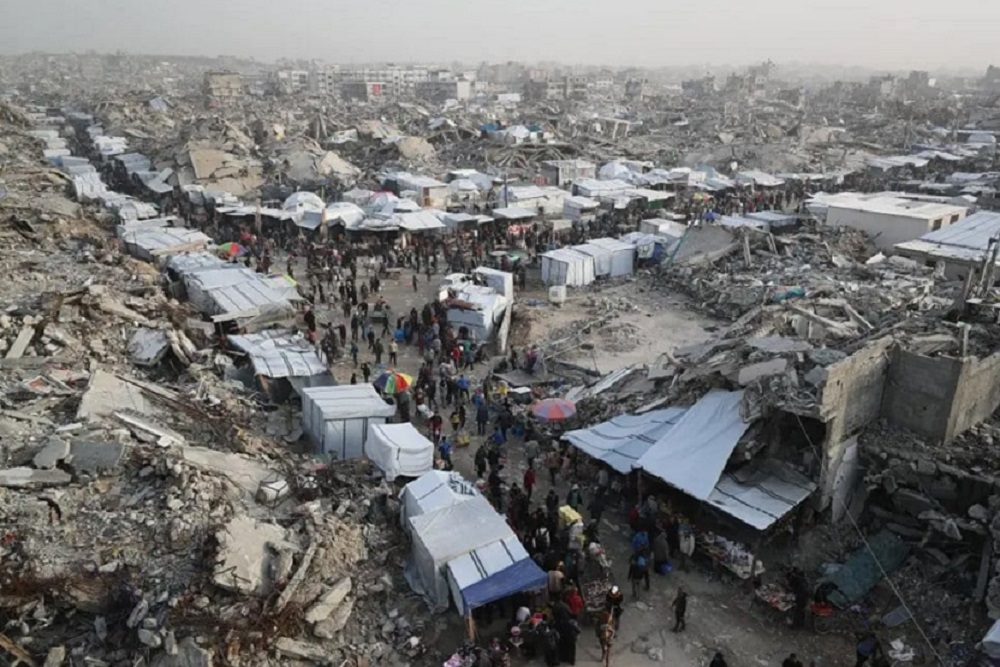As Gaza emerges from a fragile truce, tens of thousands of children face acute malnutrition, turning hunger into a weapon of war. Amid ruined hospitals, disrupted food systems, and restricted

As a fragile truce hovers over Gaza, aid organizations scramble to address an unprecedented humanitarian catastrophe. Tens of thousands of Palestinians, many of them children, are facing acute malnutrition, a crisis that is not merely a consequence of conflict but a deliberate instrument of war. The Lancet recently estimated that almost 55,000 preschool children in Gaza are acutely malnourished, highlighting the dire scale of the emergency [
i][
ii]. Aid groups describe this famine as a dual crisis: human and ecological, exacerbated by political constraints, infrastructure collapse, and environmental degradation [
iii][
iv].
Famine as a Tool of War
Two years of conflict have left Gaza’s food systems in ruins. Humanitarian agencies warn that deliberate blockade policies and targeted destruction of civilian infrastructure have weaponized hunger against an already vulnerable population [
v]. Access remains tightly restricted. The Norwegian Refugee Council warns that without full access for humanitarian groups, even the most ambitious aid plans will fail [
vi]. As UN Relief Chief Martin Griffiths outlined in a 60-day recovery plan, timely distribution of essential supplies depends critically on political compliance and safe corridors [
iv].
The consequences are stark: nearly 55,000 children under five are suffering from acute malnutrition [
i][
ii], and malnutrition-related morbidity is surging across displaced families returning to devastated homes [
vii]. Hospitals and clinics struggle to function amid power outages, damaged facilities, and dwindling medical supplies. WHO emphasizes that rebuilding Gaza’s shattered health system is essential not only for recovery but for a lasting peace [
viii].
Ecological and Humanitarian Dimensions
Beyond the immediate human toll, the crisis exposes the environmental and ecological dimensions of warfare. Waste management has collapsed, clean water is scarce, and energy shortages compromise basic sanitation, increasing exposure to disease. The convergence of human suffering and environmental degradation underscores the broader consequences of protracted conflict: famine, pollution, and ecosystem collapse are intertwined [
iii][
v][
viii].
Aid organizations are acutely aware of this multidimensional crisis. According to France24, groups are leveraging the temporary truce to deliver food, water, and medical supplies while navigating logistical and political obstacles [
iii]. Yet the scale of devastation remains daunting: even with humanitarian access, rebuilding cannot keep pace with the destruction wrought over years of siege and bombardment.
The Resilience of Gaza’s Population
Despite systemic collapse, Gaza’s population demonstrates remarkable resilience. Families improvise, communities organize mutual aid, and local volunteers become lifelines in the absence of formal systems [
v]. This human resistance is quietly political: survival itself is a form of defiance against the machinery of oppression. As Secretary-General António Guterres stressed, the UN and partners are “prepared to move—now”—but their success hinges on genuine cooperation and security for humanitarian actors [
ix].
Hope Through Coordinated Aid
A coordinated response offers a glimmer of hope. The 60-day UN plan aims to prioritize nutrition, medical care, and shelter, targeting the most vulnerable, especially children and displaced families [
iv]. Nonetheless, experts caution that partial interventions will only mitigate, not resolve, the crisis. The Norwegian Refugee Council emphasizes that full access for humanitarian groups is indispensable; without it, hunger will persist as a tool of control [
vi].
This multi-layered crisis—political, ecological, and humanitarian—calls for international accountability. The world watches not just the immediate distribution of aid, but the systemic conditions that created famine as an instrument of war. As the people of Gaza navigate each day of scarcity and danger, their resilience underscores the imperative: survival is not just a personal struggle but a collective assertion of dignity and human rights.
Sources
i. The Guardian, Almost 55,000 preschool children in Gaza acutely malnourished, Lancet study estimates, 2025. https://www.theguardian.com/world/2025/oct/08/almost-55000-children-in-gaza-acutely-malnourished-lancet-study-estimates
ii. EurekAlert!, The Lancet: Tens of thousands of children aged under five suffering acute malnutrition in Gaza, 2025. https://www.eurekalert.org/news-releases/1100998
iii. France24, Aid groups seize on truce to tackle Gaza hunger, 11 October 2025. https://www.france24.com/en/live-news/20251011-aid-groups-seize-on-truce-to-tackle-gaza-hunger
iv. OCHA, UN Relief Chief outlines 60-day plan to deliver vital aid after Gaza ceasefire, 2025. https://www.ochaopt.org/content/un-relief-chief-outlines-60-day-plan-deliver-vital-aid-after-gaza-ceasefire


Comment
Reply